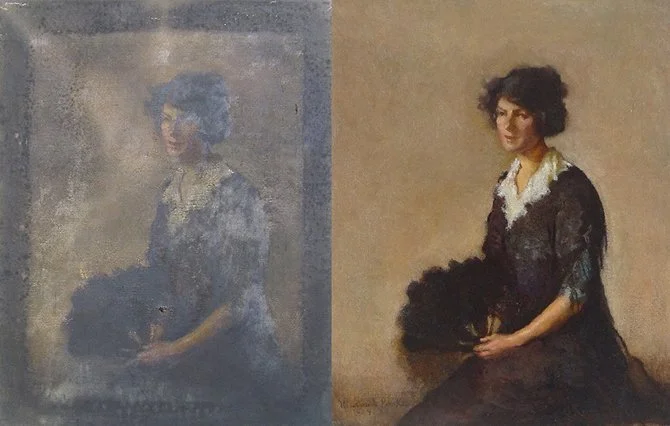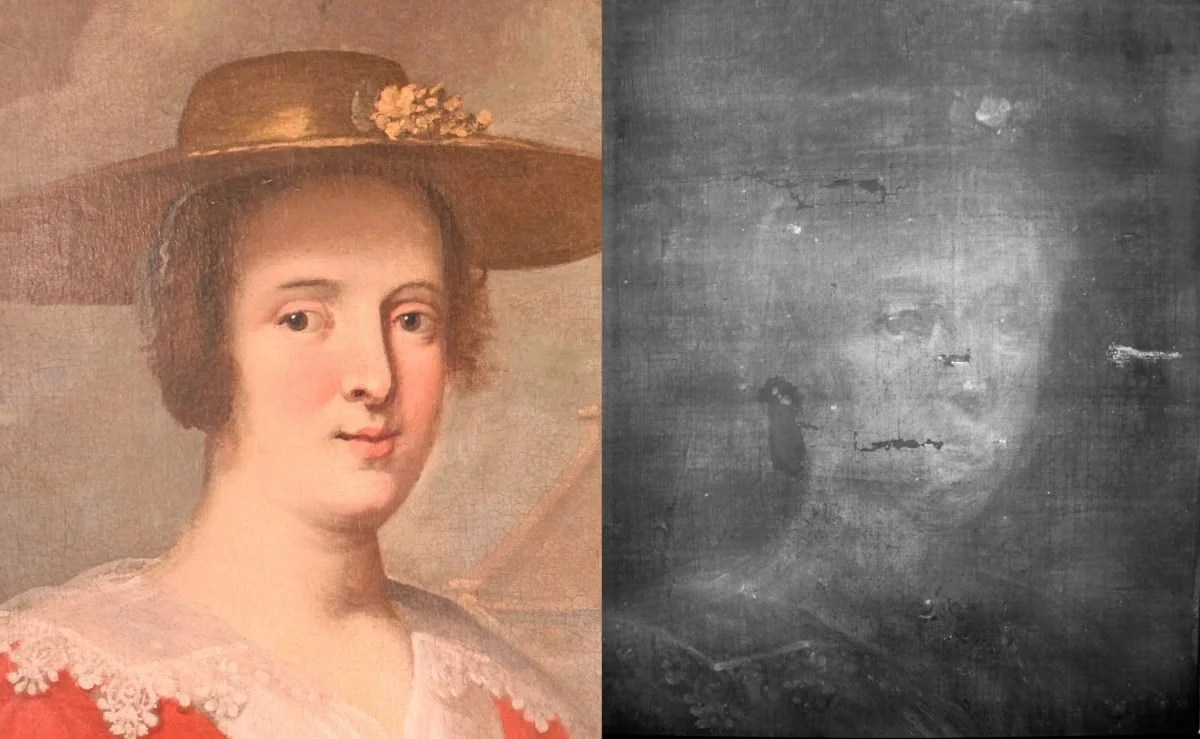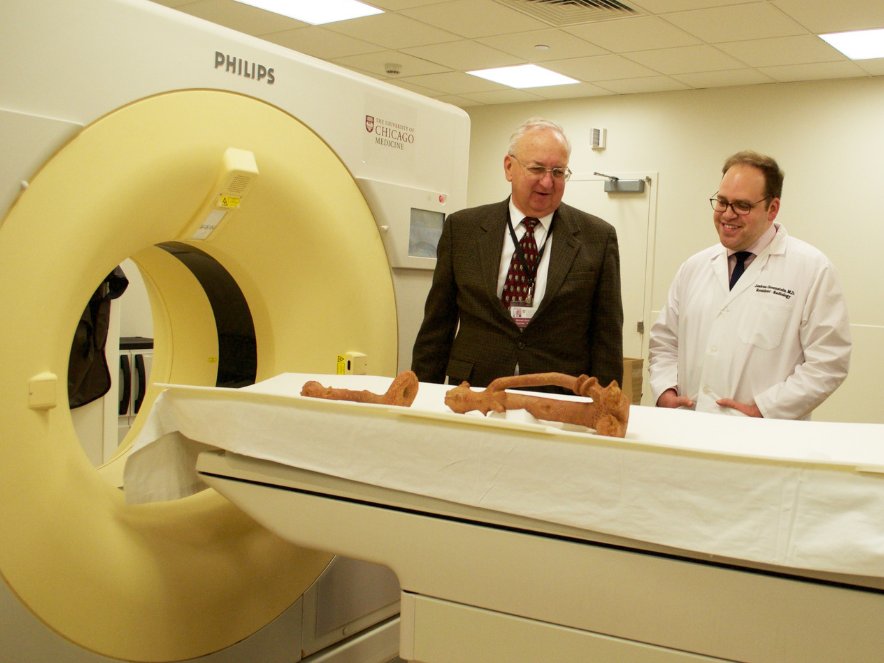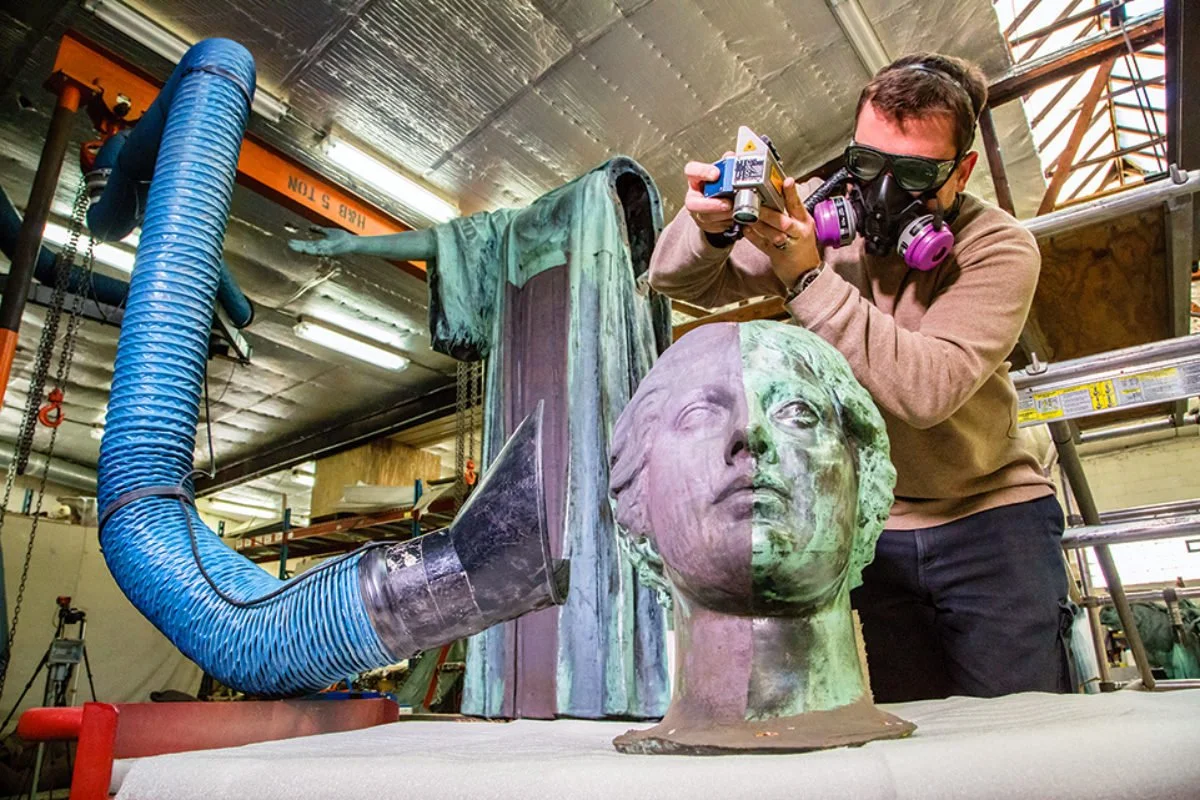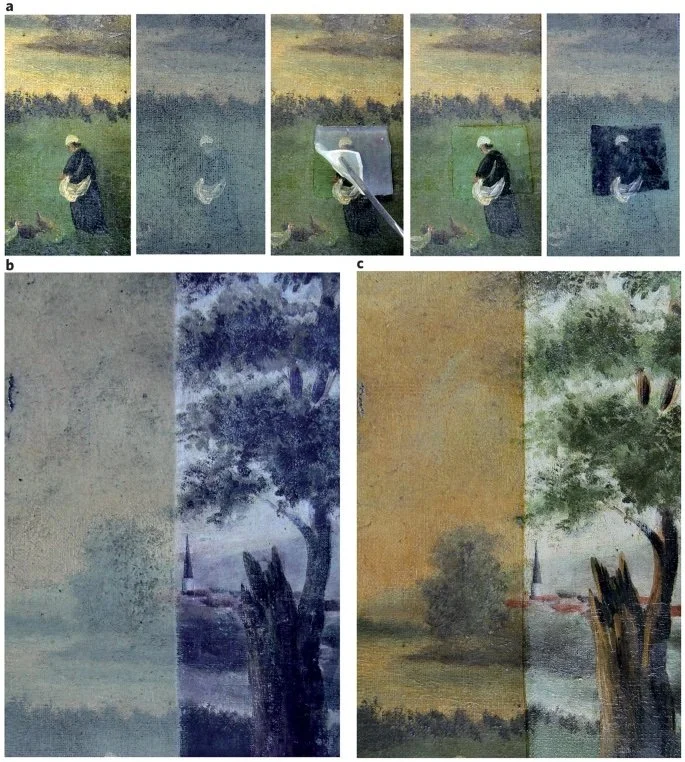Written by Rachael Johnson
In the visual arts, there is no guarantee that work will be preserved for any time after it has been created. While physical pieces are certainly more permanent that performances, all works are subject to deterioration and destruction. Some pieces are more susceptible, such as work made of fragile material or located in an unstable environment, but all pieces will eventually face wear and damage. Restoration is thus required in order to renew pieces to their original and/or best form.
Figure 1: Restorers at work. Source: E&T.
Visual arts pieces can be damaged in a variety of ways. If a piece was hung in a smoky area, such as a cathedral with candles or a living room with an owner or guests that smoked, the colors will be hidden or changed by the accumulated soot. Artists typically put a clear layer of varnish over paintings, which tends to yellow or darken over time, also affecting color. Mold or bacteria can grow on a piece, which can have devastating effects on its quality and structural integrity. Through restoration, arts professionals can determine how a piece originally looked and take steps to reveal its true appearance. While the expertise of a restoration team is invaluable for comparing the piece to others by the same artist or from the same time period, technology has enhanced the abilities of restoration teams, enabling them to more accurately perceive the piece as it was originally and more gently remove contaminants.
Figure 2: Painting with fire damage, before and after restoration. Source: Invaluable.
Before exploring visualization and cleaning technologies used in restoration, it is useful to know the difference between restoration and conservation. While occasionally used interchangeably, restoration is the repair of already damaged works, while conservation is the maintenance and preservation of works in order to prevent future damage. Restoration technologies, therefore, are created in order to view pieces in detail and clean them with as little additional damage as possible. Technology assists in this process by facilitating more precise and protective restoration measures.
Visualization Technologies
Figure 3: Painting, under x-ray on right. Source: Parma Conservation.
Visualization tools are used to examine pieces closely and see underneath layers of dirt or additional paint in order to identify the artist’s original intention. While restorers are trained to pick up on the details, there is a limit to how much the human eye can see, so technology is used to see more detail and underneath the top layer of pieces.
X-ray technology and computerized tomography (CT) scans are an excellent method to see older layers of pieces, either from the original artist or previous restoration efforts. Versions of x-ray have been used for over 100 years, and newer developments are able to see more and more hidden detail. Instead of relying on carefully removing layers, restorers are able to quickly and accurately perceive layers of material, dirt, and structural defects. X-ray is able to distinguish between these different layers so that restorers do not remove original parts of the work, and entirely hidden layers can be revealed.
Figure 4: Drs. Michael Vannier and Joshua Greenstein of the Pritzker School with the Bankoni sculptures. Source: AAAS.
CT scans are most appropriate for three-dimensional works, as a CT scan combines many x-ray “slices” to form an image of the interior of an entire piece. Utilizing CT scans provides an opportunity for arts professionals to partner with medical professionals, as was done at The Art Institute of Chicago. When Rachel Sabino, associate conservator of objects, needed to examine and authenticate West African Bankoni terracotta sculptures, she worked with the University of Chicago’s Pritzker School of Medicine to scan each piece. Restoration teams often cannot afford their own CT scanner, but partnering with the Pritzker School allowed Sabino to utilize this resource and receive assistance from experts in CT technology.
Meanwhile, microscopes are used in order to see the surface of a piece more closely, including artistic details, physical damage, or contaminants. Restorers use medical-grade microscopes to view a piece in micrometers or millimeters as they complete repairs, a scale which is invisible to the human eye. Through this level of microscopy, pieces can be cleaned and retouched much more precisely and safely. The video below demonstrates how a microscope was used to repair holes in the canvas of “Self Portrait,” painted by Paula Modersohn-Becker in 1907, without removing the canvas from its original stretcher.
Figure 5: Microscopically reweaving a 1907 painting. Source: Youtube.
Figure 6: Painting, under-near infrared light on right. Source: Parma Conservation.
Arts professionals are often interested in the artist’s original intention for a piece. By viewing the original sketches of a painting, restorers have a better context and a clearer end goal for their repairs – while the original sketch may or may not reflect the artist’s goal for the work, it is invaluable information to see their process. Infrared cameras are best suited for this work, as infrared light goes through pigment to be reflected off of the original surface or be absorbed by carbon-rich materials, such as marks made by carbon pencils. An image of these reflections and absorptions shows the original sketch, and the non-invasive process preserves all layers of the piece for further work.
Cleaning Technologies
Cleaning visual artworks can be an incredibly difficult process, and restorers must balance their goals to remove as many contaminants as possible while preserving the artistic details. While some methods may be effective, they may be too abrasive depending on the material of the piece. However, if left, some contaminants will cause further damage. Cleaning technologies enable restorers to gently but thoroughly remove dirt, soot, varnish, mold, and bacteria so that viewers can see the full beauty of the piece and so that it can be maintained for decades and centuries to come.
Laser ablation is a technique that removes dirt and varnish in a minimally-invasive way, as it does not require a solvent or manual action. A single wavelength, typically in the infrared range, is selected and emitted in a focused beam. The wavelength will interact with dirt and varnish, heating the particles so much that they will be expelled off of the piece. The process used to be much more dangerous to use, because restorers had to estimate the amount of time necessary to remove only dirt and varnish. If the laser is used for too long, it will begin to also heat and remove pigment. Now, there is a method called Laser Induced Breakdown Spectroscopy (LIBS) which monitors the energy emitted from the particles being removed. When the energy shifts, the system recognizes that the laser has begun to interact with pigment, and it automatically shuts off the laser. LIBS thus removes human error, making laser ablation a safe way to remove dirt and varnish. Laser ablation can be used on paintings, stone, gilded bronze, and frescoes, and devices are often handheld and thus easily portable.
Figure 7: Alma Mater from the University of Illinois working on a half cleaned bust by laser ablation. Source: University of Illinois.
While using bacteria to clean artworks may seem counterproductive, some strains actually consume dirt, providing a minimally invasive, quick, and focused way to remove contaminants. These strains metabolize both organic and inorganic materials into gases such as hydrogen sulfide and carbon dioxide. As with CT scanning, bacterial cleaning offers opportunities for collaboration between arts professionals and medical professionals, particularly microbiologists, who test and develop the bacterial strains used. Pilar Bosch, a biologist with Polytechnic University in Valencia, Spain, observed that frescoes that she assisted in restoring ten years previously showed no adverse effects from the bacterial cleaning.
While many solvents used in the past are now considered too harsh, nanotechnology has been used to produce much gentler and more effective formulas. Some problems in restoration had previously stymied arts professionals, as there was no clear solution. These issues include removing beeswax from frescoes, removing polymer coatings from murals, rebuilding calcite in frescoes, and de-yellowing and strengthening paper. All previous efforts only damaged pieces further, but the type and size of molecules able to be developed with nanotechnology were enormously successful at cleansing and repairing these works.
Figure 8:
A: Photographs of the painting and of hydrogel application. From left to right: the painting before cleaning (visible light); the painting before cleaning (ultraviolet light); the application of the hydrogel (visible light); the painting after cleaning (visible light); and the painting after cleaning (ultraviolet light).
B: Ultraviolet photographs of the painting showing the feasibility of using chemical gels over a large area. Left image, not cleaned; right image, cleaned.
C: Visible light photographs of the painting showing the feasibility of using chemical gels over a large area. Left image, not cleaned; right image, cleaned.
Source: Nature Nanotechnology.
Digital Art Restoration
In addition to improving restoration efforts for traditional art forms, technology has increased the production of digital art and subsequently, its need for restoration. The primary challenges for digital pieces are rapidly changing software systems, hardware going out of production, and changes in color specifications. Arts professionals often collaborate with computer scientists in order to restore these works, but it can be a complicated process. Restoration cannot simply be conducted by updating the piece or its system, it must be conducted with respect to the artist’s original vision, much like restoration of traditional art forms. Through a collaborative process incorporating creative and technical elements, restorers can successfully display and preserve digital media.
Conclusion
Technology has become an essential and invaluable part of the art restoration process, and the field continues to evolve. Restoration practices are still being determined for artistic media and methods used in the 20th century, such as acrylic paints. Further technological advancements, including artificial intelligence, are opening up new possibilities. Ultimately, the goal of restoration is to safely and accurately bring pieces to their best form for study and public enjoyment. Through technology, this goal can be accomplished.
+ Resources
Baglioni, P., E. Carretti, and D. Chelazzi. “Nanomaterials in Art Conservation.” Nature Nanotech 10 (April 9, 2015): 287–90. https://doi.org/https://doi.org/10.1038/nnano.2015.38.
Bagwell, Sam. “The Beauty of Science: New Technologies in Art Restoration.” Illumin Magazine. USC Viterbi School of Engineering, December 8, 2004. https://illumin.usc.edu/the-beauty-of-science-new-technologies-in-art-restoration/.
Brazil, Rachel. “Modern Chemistry Techniques Save Ancient Art.” Scientific American. Chemistry World, June 28, 2014. https://www.scientificamerican.com/article/modern-chemistry-techniques-save-ancient-art/.
Schoenmann, Peter. “Art Restoration Technology.” Parma Conservation, November 19, 2019. https://parmaconservation.com/art-restoration-technology/.
Song, Juwon. “Technology Ensures Conservation of Art, Old and New.” American Association for the Advancement of Science. American Association for the Advancement of Science, February 16, 2019. https://www.aaas.org/news/technology-ensures-conservation-art-old-and-new.
The Museum of Modern Art. “Microscopically Reweaving a 1907 Painting | CONSERVATION STORIES.” YouTube. YouTube, September 12, 2019. https://www.youtube.com/watch?v=odeG3HBEpSQ&t=141s.
“The Science Behind the Restoration of a Painting.” Invaluable. Invaluable, May 29, 2019. https://www.invaluable.com/blog/the-science-behind-art-restoration/.
Timmins, Mary. “Lady in Waiting.” University of Illinois Alumni. University of Illinois Alumni Association, June 3, 2014. https://uiaa.org/2014/06/03/lady-in-waiting/.
Williams, Len. “Art Restoration and Conservation: Restoring Former Glories.” E&T. The Institution of Engineering and Technology, May 22, 2019. https://eandt.theiet.org/content/articles/2019/05/art-restoration-and-conservation-restoring-former-glories/.



